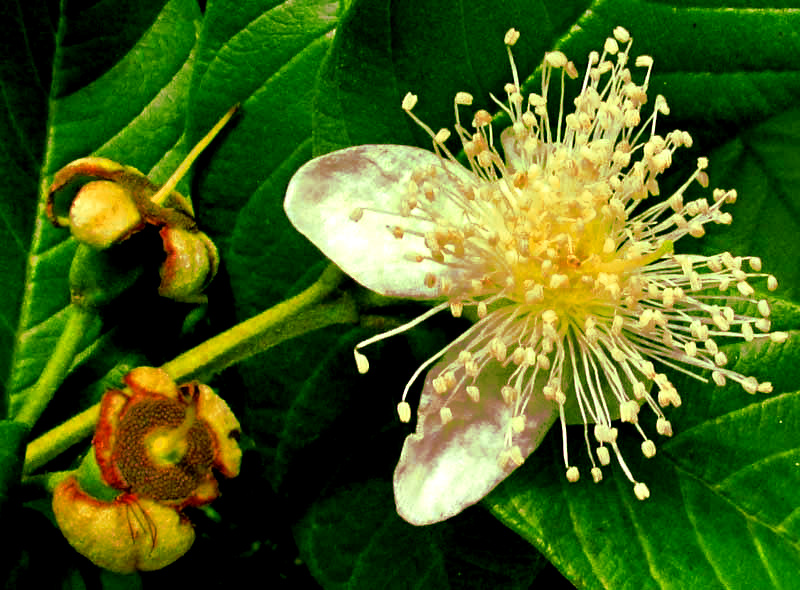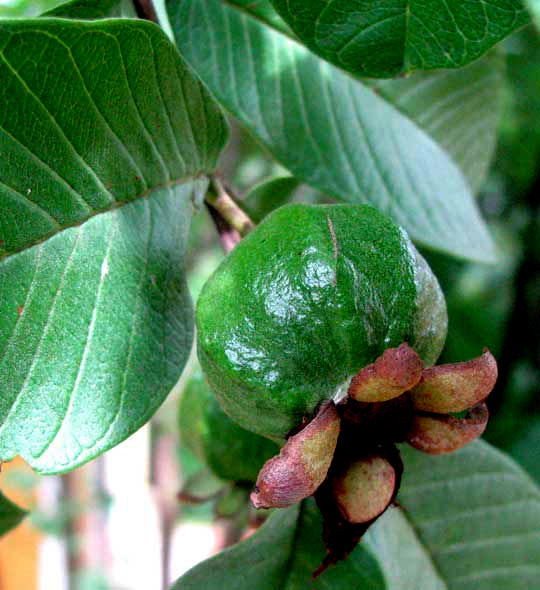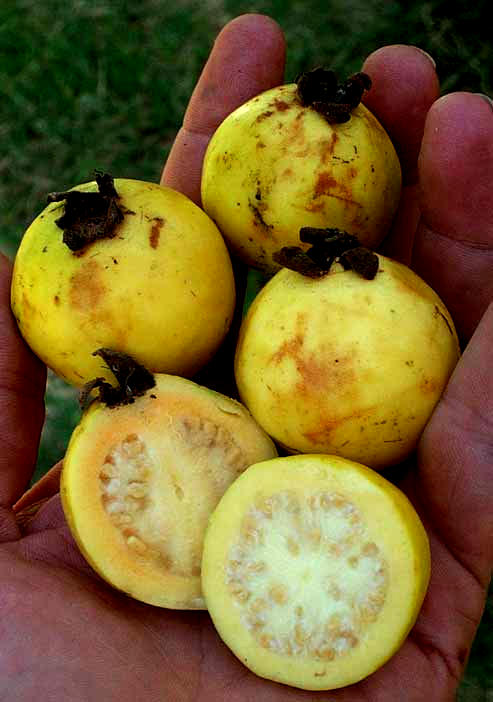Excerpts from Jim Conrad's
Naturalist Newsletter
issued July 2, 2020 from Tepakán, Yucatán, MÉXICO
GUAVA FLOWERS
In Tepakán the Guava trees are flowering, shown below.

Guava plants belong to the Myrtle Family, whose flowers normally produce numerous pollen-producing stamens, often making the flowers more attractive, and that's the case with Guava flowers. In the picture, if you look closely, nestled among all the stamens you can see a slender, greenish style, which is the ovary's "neck." It's tipped with a knobby style, which is where pollen grains germinate. Once the flower is pollinated, the white petals and stamens fall off, leaving the ovary to mature into a guava fruit, which people here love to eat. A peculiarity of the maturing ovary is that the flower's calyx lobes, which on most flowers disappear, on Guava flowers enlarge and become tough and leathery, even remaining on the fruit. The style also remains during much of the fruit development.
from the July 4, 2010 Newsletter issued from Hacienda Chichen Resort beside Chichén Itzá Ruins, central Yucatán, MÉXICO
GUAVA'S CALYX LOBES
Especially when kept watered, guava trees, PSIDIUM GUAJAVA of the Myrtle Family, might produce guava fruits almost anytime. Certain trees here are bearing fruit now and you can see a half-grown one below:

A botanist would describe that fruit as a "globose berry," globose another word for spherical, and berry being meant in the technical sense. Technically a berry is a pulpy fruit resulting from a single pistil (the flower's stigma, style and ovary), and containing one or more seeds but no true stone (big and hard like a plum seed). A tomato is an excellent berry. Strawberries and blackberries aren't even close to being berries, but blueberry fruits are indeed berries.
Anyway, at the stage of development of the guava fruit in the picture, the most conspicuous feature is that of the five leathery, purplish items at the fruit's bottom.
To grasp what they are you need to remember that a typical flower has its colored corolla and sexual parts arising from a green, cuplike calyx. Most calyxes have five lobes, or sepals. The five leathery, purplish items in the picture, then, are the calyx lobes, or sepals, remaining on the maturing fruit long after the flower's corolla and male sexual parts have shriveled and fallen off. In most flowers the calyx and its lobes also shrivel and fall off, so these "persistent calyx lobes" on guava fruits are something special about the fruits.
from the June 15, 2007 Newsletter issued fromSierra Gorda Biosphere Reserve, QUERÉTARO, MÉXICO
HARD TO HIDE AS A GUAVA
I'm reading a Mexican novel in which the characters speak down-home Spanish. "Hard to hide as a guava" is one colorful expression I've run across. Of course every Mexican knows why a guava is so hard to hide: Because of its powerful odor.
The other day Don Ereberto gave me a bag of guavas he'd bought at the market, shared with his friends, and now didn't want any more. It was late and I wasn't hungry, so I stored the bag on my desk. About midnight I had to get up and put the bag outside because the odor was so penetrating I just couldn't stand it.
It's one of those odors that at first strikes you as delicious and perfumy, with only a slightly musky undercurrent. But as time passes the muskiness takes over, grows heavy, smoothers with its insistent fragrance, and I am sure there must be pheromones involved working at the subconscious level. The odor of ripe guava is too like the voluptuous love affair that reaches unimagined fulfillment and then deep in the bosom of a certain languid, exhausted night this question arises: Now what? Heavy, heavy, even suffocating, and I put those guavas outside where the night air could carry their fragrance to less jaded nostrils and souls.
Guavas, called guayabas in Spanish, have been grown horticulturally for so long that many varieties have arisen. You can see the type commonly seen here below:

The many varieties are regarded as having been developed from two guava species. The typical yellow guava is PSIDIUM GUAJAVA, while the usually smaller, purplish-red "Strawberry Guava" is PSIDIUM CATTLEIANUM. Guavas are members of the Myrtle Family, in which we also find eucalyptuses and Allspice. The family is famous for its species producing aromatic oils.
In the above photograph, notice the dark, leathery items messily adhering to the top of each fruit. These are old calyx-lobes, the calyx being the usually greenish, cup-like thing out of which the corolla arises. Calyx lobes usually wither and either fall off or remain very inconspicuous as the fruit develops. For some reason they remain on guavas, and their presence is one way you can distinguish guavas from other medium-size, yellow or red fruits.